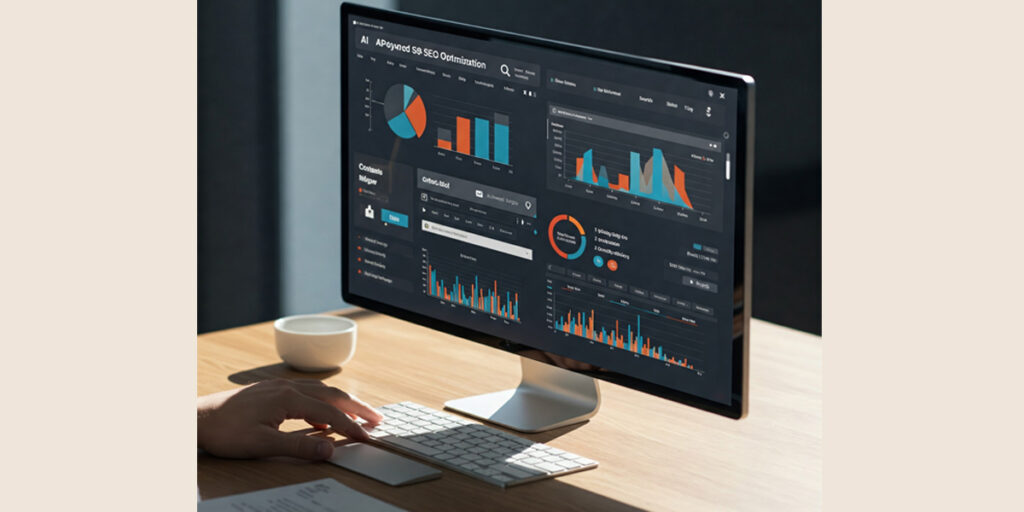SEO-focused AI that helps generate optimized blog posts
Riding the Wave Towards an AI-Powered Future of SEO
Surfer AI represents a significant milestone in the evolution of SEO, harnessing the power of artificial intelligence to streamline content creation and optimization. Its history is rooted in the growing need for efficiency and data-driven strategies in a complex digital landscape. Its position within the economic market for AI-powered SEO tools is strong, driven by the demand for organic traffic and the increasing sophistication of search engine algorithms. The networking effects it fosters within the digital marketing ecosystem further enhance its value and contribute to its ongoing growth.
As AI continues to evolve, tools like Surfer AI will undoubtedly play an increasingly important role in shaping the future of SEO. By automating key tasks, providing data-driven insights, and empowering content creators to generate optimized content at scale, Surfer AI is helping businesses navigate the algorithmic waves and achieve greater online visibility in the ever-expanding ocean of the internet. The journey is far from over, and as the tides of technology continue to shift, Surfer AI, along with the broader field of AI in SEO, will undoubtedly continue to adapt, innovate, and redefine the art and science of reaching online audiences.
The digital landscape, a vast and ever-shifting ocean of information, demands constant navigation for businesses seeking visibility. In this environment, Search Engine Optimization (SEO) has emerged as the compass and the sails, guiding websites toward the coveted shores of the first page of search engine results. For years, SEO was a domain of meticulous manual work, involving painstaking keyword research, content analysis, and backlink building. However, the rise of artificial intelligence (AI) has begun to transform this landscape, ushering in a new era of automated optimization. At the forefront of this AI-driven revolution stands Surfer AI, a tool that has rapidly gained prominence for its ability to generate SEO-optimized blog posts with a strong emphasis on keyword targeting. To truly understand the impact and potential of Surfer AI, we must delve into its historical context, analyze its position within the economic market, and explore the networking effects it fosters within the digital marketing ecosystem.
The Genesis of SEO and the Pre-AI Era
The history of SEO is inextricably linked to the rise of the internet and, more specifically, the dominance of search engines like Google. In the early days of the web, discoverability was a significant challenge. As the volume of online content exploded, search engines emerged as the primary gateways to information. The algorithms these search engines employed to rank web pages became the subject of intense scrutiny and the foundation of SEO practices.
Initially, SEO was a relatively rudimentary affair. Early algorithms heavily relied on keyword matching – the presence of specific keywords within the content of a webpage. This led to practices like keyword stuffing, where websites would excessively repeat keywords in an attempt to game the system. As search engine algorithms evolved, they became more sophisticated, taking into account factors like link quality, website structure, and user experience.
The pre-AI era of SEO was characterized by manual research and analysis. SEO professionals spent countless hours:
- Conducting Keyword Research: Identifying relevant and high-volume keywords that potential customers were using to search for products or services. This involved using tools to analyze search volumes, keyword difficulty, and related terms.
- Analyzing Competitor Content: Examining the top-ranking pages for target keywords to understand their content structure, keyword usage, and overall SEO strategies.
- On-Page Optimization: Manually optimizing website elements such as title tags, meta descriptions, headings, and the body content itself to incorporate target keywords naturally and effectively.
- Content Creation: Writing blog posts and website copy with SEO considerations in mind, ensuring keyword integration and providing valuable information to users.
- Link Building: Acquiring backlinks from other reputable websites, a crucial factor in establishing authority and improving search engine rankings.
This manual approach was time-consuming, often requiring a deep understanding of evolving search engine algorithms and a significant investment of resources. The process was also prone to human error and biases, making it challenging to consistently achieve top rankings.
The AI Disruption: A New Paradigm for SEO
The advent of AI technologies, particularly Natural Language Processing (NLP) and machine learning, marked a significant turning point in the evolution of SEO. AI offered the potential to automate many of the time-consuming and data-intensive tasks associated with optimization, providing insights and efficiencies previously unimaginable.
Several AI-powered tools began to emerge, each focusing on different aspects of SEO. Some tools specialized in keyword research, using AI to identify emerging trends and uncover hidden keyword opportunities. Others focused on technical SEO, analyzing website structure and identifying areas for improvement. However, Surfer AI distinguished itself by focusing on content creation and optimization, leveraging AI to generate blog posts that were not only readable but also strategically aligned with target keywords and competitor analysis.
The History of Surfer AI: Riding the Initial Wave
While specific founding dates and early developmental milestones might be proprietary information, the emergence of Surfer AI can be understood within the broader context of the growing demand for efficient and data-driven content creation in the SEO space. Recognizing the limitations of manual content optimization and the potential of AI, the creators of Surfer AI aimed to develop a solution that could:
- Automate Content Research: Quickly analyze top-ranking content for target keywords, identifying key topics, concepts, and semantic relationships.
- Provide Data-Driven Insights: Offer actionable recommendations on content structure, keyword density, heading usage, and other on-page factors based on competitor analysis.
- Generate Optimized Content: Leverage AI to produce blog posts that incorporate these insights, aiming for higher search engine rankings.
The initial iterations of Surfer AI likely focused on core functionalities like keyword analysis and content scoring. As the technology matured, the platform expanded to include AI-powered content generation capabilities. This marked a significant leap, moving beyond simply providing recommendations to actively assisting in the content creation process itself.
The rapid adoption of Surfer AI within the SEO community can be attributed to several factors:
- Efficiency Gains: The ability to generate optimized content quickly and efficiently significantly reduced the time and resources required for content creation.
- Data-Driven Approach: By grounding content creation in data-backed analysis of top-ranking pages, Surfer AI offered a more scientific and potentially more effective approach to SEO.
- Accessibility: The user-friendly interface and comprehensive features made it accessible to a wide range of users, from individual bloggers to large marketing agencies.
- Continuous Improvement: The platform likely underwent continuous updates and improvements, incorporating user feedback and adapting to changes in search engine algorithms.
The name “Surfer AI” itself evokes the image of navigating the waves of the internet, riding the algorithmic currents to reach the top of search results. This branding likely resonated with SEO professionals seeking a tool to help them effectively navigate the complexities of online visibility.
The Economic Market for AI-Powered SEO Tools
The emergence of Surfer AI and similar tools has created a dynamic and rapidly growing economic market. This market is driven by the fundamental need for businesses to achieve online visibility and attract organic traffic. The key economic factors shaping this market include:
- Demand for Organic Traffic: Organic search remains a primary source of website traffic for many businesses, offering high-intent users who are actively searching for relevant information, products, or services.
- Increasing Competition: The online landscape is becoming increasingly competitive, with more businesses vying for top search engine rankings. This intensifies the need for effective SEO strategies and tools.
- Complexity of SEO: As search engine algorithms become more sophisticated, the intricacies of SEO have increased. This complexity drives demand for tools that can simplify and automate the optimization process.
- Value Proposition of AI: AI offers the potential to analyze vast amounts of data, identify patterns, and generate insights at a scale and speed that is impossible for humans. This provides a significant value proposition for businesses seeking a competitive edge in SEO.
- Pricing Models: The economic market for AI-powered SEO tools typically features subscription-based pricing models, offering different tiers based on usage limits and features. This recurring revenue model allows companies like Surfer AI to invest in further development and innovation.
Market Segmentation: The market for AI-powered SEO tools can be broadly segmented into:
- Content Optimization Tools: Focus on analyzing and optimizing existing content or generating new content for SEO purposes (e.g., Surfer AI, Jasper, Copy.ai).
- Keyword Research Tools: Leverage AI to identify relevant keywords, analyze search trends, and uncover competitor strategies (e.g., Semrush, Ahrefs with AI features).
- Technical SEO Tools: Use AI to analyze website structure, identify technical issues, and provide recommendations for improvement (e.g., Screaming Frog with AI integrations).
- Comprehensive SEO Platforms: Integrate multiple AI-powered features for various aspects of SEO, offering a holistic solution (e.g., some enterprise-level SEO platforms).
Competitive Landscape: The market for AI-powered SEO tools is becoming increasingly competitive. Established SEO software providers are integrating AI features into their existing platforms, while new AI-focused startups are constantly emerging. Surfer AI has carved a niche by focusing heavily on content optimization and generation, offering a unique value proposition that resonates with content marketers and SEO professionals.
Market Growth Potential: The market for AI in SEO is expected to continue its rapid growth trajectory. As AI technology advances and search engine algorithms become even more complex, the demand for intelligent automation in SEO will only increase. Businesses will increasingly rely on AI-powered tools to streamline their workflows, gain data-driven insights, and achieve sustainable organic growth.
Networking Effects and the Surfer AI Ecosystem
Beyond its core functionality, Surfer AI contributes to and benefits from various networking effects within the digital marketing ecosystem:
- Community Building: Surfer AI has fostered a community of users who share best practices, strategies, and insights related to AI-powered content optimization. This community often forms around online forums, social media groups, and shared experiences with the tool. The collective knowledge and support within this network enhance the value proposition of Surfer AI.
- Integration with Other Tools: Surfer AI often integrates with other popular SEO and content marketing tools, such as Google Docs, WordPress plugins, and keyword research platforms. These integrations create a more seamless workflow for users and enhance the overall value of the Surfer AI ecosystem. For example, a direct integration with a keyword research tool allows users to seamlessly import target keywords into Surfer AI for content generation.
- Knowledge Sharing and Education: Surfer AI often provides educational resources, such as webinars, blog posts, and tutorials, to help users understand how to effectively leverage AI for SEO. This knowledge sharing contributes to the overall sophistication of the SEO community and reinforces Surfer AI’s position as a thought leader in the space.
- Feedback Loops and Product Improvement: User feedback from the Surfer AI network plays a crucial role in the ongoing development and improvement of the platform. By actively engaging with its user base, Surfer AI can identify areas for enhancement, address user pain points, and ensure that the tool remains aligned with the evolving needs of the market.
- Partnerships and Collaborations: Surfer AI may also form partnerships with other companies in the digital marketing space, such as content writing agencies or SEO consulting firms. These collaborations can expand the reach of Surfer AI and further integrate it into the broader marketing ecosystem.
The strength of these networking effects contributes significantly to the stickiness and long-term success of Surfer AI. As more users adopt the platform, share their experiences, and integrate it into their workflows, the value of the tool increases for everyone within the network.
The Future of Surfer AI and AI in SEO
The future of Surfer AI and AI in SEO is likely to be characterized by continued innovation and integration. We can anticipate several key trends:
- Enhanced Natural Language Processing (NLP): AI models will become even more sophisticated in understanding the nuances of human language, allowing for the generation of even more natural-sounding and engaging content. Surfer AI will likely leverage these advancements to produce content that not only ranks well but also resonates deeply with readers.
- Deeper Integration with Search Engine Algorithms: AI tools will become increasingly adept at understanding and adapting to the ever-evolving algorithms of search engines like Google. Surfer AI will need to continuously refine its models to stay ahead of these changes and ensure that the content it generates remains effective.
- Personalization and Contextualization: Future AI-powered content generation may become more personalized, tailoring content to specific audience segments and even individual users based on their browsing history and preferences. Surfer AI could potentially incorporate features that allow for the creation of highly targeted content.
- Multimodal Content Generation: AI may expand beyond text-based content to generate other forms of media, such as images, videos, and audio, all optimized for SEO. Surfer AI could potentially integrate these capabilities in the future.
- Ethical Considerations: As AI plays a larger role in content creation, ethical considerations such as plagiarism, bias in AI models, and the potential for generating low-quality or misleading content will become increasingly important. Surfer AI and other AI-powered SEO tools will need to address these concerns proactively.
- Focus on User Experience: While SEO is crucial for discoverability, the ultimate goal is to provide value to users. Future AI tools will likely place an even greater emphasis on generating content that not only ranks well but also provides a positive and engaging user experience. Surfer AI will need to balance keyword optimization with readability and user intent.
- Integration with Analytics: Deeper integration with analytics platforms will allow users to track the performance of AI-generated content more effectively and refine their strategies based on real-world data. Surfer AI could enhance its platform by providing more robust analytics dashboards and reporting features.




















